"Going now to take my leave of Surinam, after all the horrors and cruelties with which I must have hurt both the eye and the heart of the reader, I will close with an emblematical picture of Europe supported by Africa and America, accompanied by an ardent wish that the friendly manner as they are represented, they may henceforth and to all eternity be the props of each other... We only differ in colour, but are certainly all created by the same hand."
[Capt. John Gabriel Stedman]
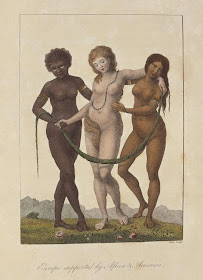
'Europe Supported by Africa and America'
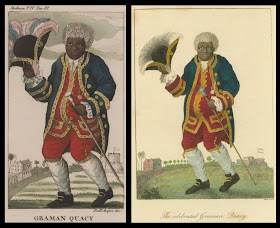
A black man in eleborate European dress with a feathered cocked hat, watch, and a walking stick stands before a dwelling, fortifications with a Dutch flag, and soldiers drilling. Quacy, or Kwasi, was born in West Africa ca. 1690 and transported to Suriname as a child. By 1730, he had discovered the medicinal properties of the Quassiehout, Quassia amara, and served during the next six decades as the colony's leading medicine man with vast influence over all the inhabitants, black, white, and native, of Suriname. He was also the colony's principal intermediary in dealing with maroons*, serving first as a scout, then a negotiator, and then as an advisor to the Rangers. Kwasi was manumitted*, became a planter, and remained active well into his nineties.
{the later Italian version on the left; the original by William Blake on the right}
"Stedman, a member of the Scots Brigade in the Netherlands, went to Surinam to help repress a revolt of former slaves. His book, translated into six languages, describes, among other things, the cruel treatment of slaves in that colony. His book was originally illustrated by William Blake, Francesco Bartolozzi, and others; those illustrations have been copied and slightly reinterpreted by the illustrator of this [Italian] edition. The text of this edition is based on the 1798 French edition. The artist could be Cristoforo dall'Acqua, Austrian printmaker and draftsman."

'Indiana Arrowukas'
{'The term Arawak (from aru, the Lokono word for cassava flour), was used
to designate the Amerindians encountered by the Spanish in the Caribbean.')
to designate the Amerindians encountered by the Spanish in the Caribbean.')
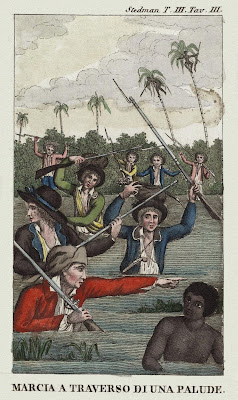
'Marcia a traverso di una palude'
[Capt. Stedman is said to be amongst this party attempting to cross a swamp]
[Capt. Stedman is said to be amongst this party attempting to cross a swamp]

Self Portrait [of/by Capt. John Gabriel Stedman] engraved by Bartolozzi.

'Un Negro in Sentinella' (Negro lookout)
A black man gestures while looking behind him. He holds a gun, wears a fur bag attached to a strap, and has a hatchet or ax held by another strap. Two more black men with guns run behind him. Includes bone and skull on ground.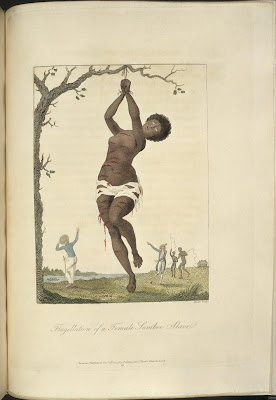
'Flagellation of a Female Samboe Slave'
Capt. Stedman: "[the] first object which presented itself after my landing ... a young female slave, whose only covering was a rag tied round her loins, which, like her skin, was lacerated in several places by the stroke of the whip. The crime which had been committed by this miserable victim of tyranny, was the nonperformance of a task which she was apparently unequal, for which she was sentenced to receive two hundred lashes, and to drag during some months, a chain several yards in length, one end of which was locked around her ancle, and the other was affixed a weight of at least a hundred pounds..."
'Giovanna'
A black, female slave holding a hat stands in a landscape.
Her hair is decorated with a flower and several gold ornaments.
Her hair is decorated with a flower and several gold ornaments.
Capt. Stedman:
"Till this time, I had been chiefly Joanna's friend; but now I began to feel that I was her captive. I renewed my wild proposals of purchasing, educating, and transporting her to Europe; but though these offers were made with the most perfect sincerity, she once more rejected them, with the following humble declaration:
'I am born a low, contemptible slave. Were you to treat me with too much attention, you must degrade yourself with all your friends and relations. The purchase of my freedom is apparently impossible; it certainly will prove difficult and expensive. Yet though I am a slave, I hope I have a soul not inferior to Europeans. I do not blush to avow the great regard I have for one, who has distinguished me so much above others of my unhappy birth. You have, sir, pitied me; and now, independent of every other thought, I have pride in throwing myself at your feet, till fate shall part us, or my conduct become such as to give you cause to banish me from your presence.'
She uttered this with a timid, downcast look, and the tears fell fast upon her heaving bosom, while she held her companion by the hand. From that moment this excellent creature was mine; nor had I ever any cause to repent of the step I had taken."
[Stedman would return to Holland without Joanna, but their son joined his father and new Dutch step-mother in Europe after Joanna's death (she was ultimately freed from slavery)]
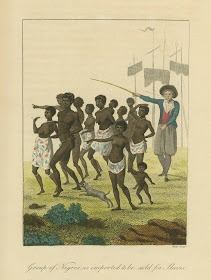
'Group of Negros, as imported to be sold for Slaves'
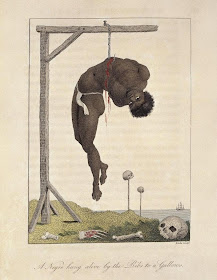
'Negro hung alive by the Ribs to a Gallows'
[Capt. Stedman did not witness this torture but heard
about it from 'a decent looking man'. The victim was apparently
kept alive for three days and never complained.]
about it from 'a decent looking man'. The victim was apparently
kept alive for three days and never complained.]
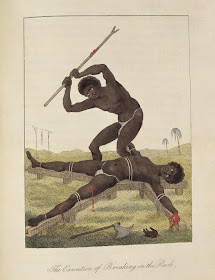
'Execution of Breaking on the Rock'
Capt. Stedman:
"[Neptune was] a Carpenter by Trade, he was Young and handsome – But . . . he having Stole a Sheep to Entertain some Favourite Women, the Overseer had Determined to See him Hang'd, Which to Prevent he Shot him dead Amongst the Sugar Canes – this man being Sentenced to be brook Alive upon the Rack, without the benefit of the Coup de Grace, or mercy Stroke, laid himself down Deliberately on his Back upon a Strong Cross, on which with Arms & Legs Expanded he was Fastned by Ropes–The Executioner / also a Black / having now with a Hatchet Chop'd off his Left hand, next took up a heavy Iron Crow or Bar, with Which Blow After Blow he Broke to Shivers every Bone in his Body till the Splinters Blood and Marrow Flew About the Field, but the Prisoner never Uttered a Groan, or a Sigh."
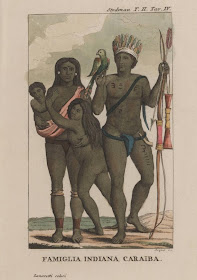
'Famiglia Indiana Caraiba'
Native American man, woman, child, and baby. Includes bow and arrows, feathered headdress, parrot, body ornaments, and tattoos. Both the Caribs and Arawaks inhabited Surinam, but the Caribs pushed the Arawaks out. They referred to themselves as the Kali'na.
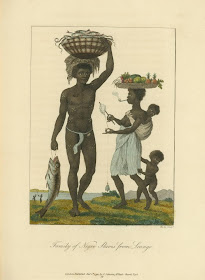
'Family of Negro Slaves from Loango'
Family of negro slaves with father, pregnant mother, and two children. Details include basket of fish, basket of fruits, spindle, tattoos (including a brand of the initials "JGS"), and tobacco pipe.
[JGS was Capt. Stedman's initials]

'Female Negro Slave with a Weight chained to her Ankle'
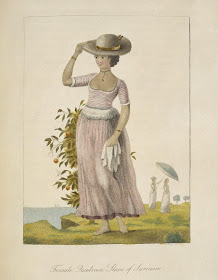
'Female Quadroon*, Slave of Surinam'
[Quadroon, the name given to a person quarter-blooded,
in particular the offspring of a mulatto and a white person.]
in particular the offspring of a mulatto and a white person.]
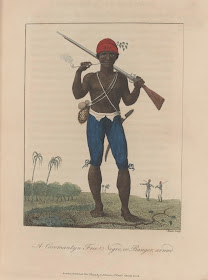
'A Coromantyn Free Negro, or Ranger, armed'
A tattooed black man, wearing only pants, stands holding a musket on one shoulder. He also holds a pipe, sword, and has pouches slung across his chest. He wears a scarlet cap with a number on it. Text describes how the Maroon privates wore a scarlet cap, the symbol of liberty, with their number in[s]cribed on it.
"The new raised corps of manumitted slaves, who [..have..] given astonishing proof of theyr fidelity to the Europeans and theyr valour against the revolters . . . . they are arm'd only with a firelock and sabre . . . they generally go naked by preference in the woods except trowsers and a scarlet cap on which is theyr number, and which . . . distinguishes them from the rebels in any action"
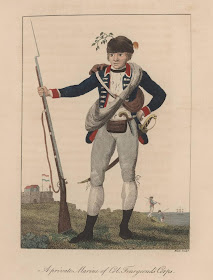
'A private Marine of Col. Fourgeoud's Corps'
Common marine in military regalia holding a musket
with bayonet. Military aspects include pistol, sword, knapsack,
hammock, fortifications, leather cap with a plant in it, and a ship.
with bayonet. Military aspects include pistol, sword, knapsack,
hammock, fortifications, leather cap with a plant in it, and a ship.
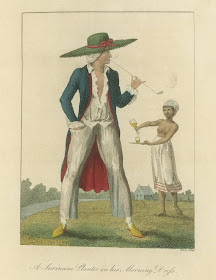
A Surinam Planter in his Morning Dress.
Man smoking a pipe and wearing sleeping attire and
a large hat is served wine by a black [slave] woman.
Man smoking a pipe and wearing sleeping attire and
a large hat is served wine by a black [slave] woman.

[a] Brown capuchin monkeys swing in trees The monkeys are brown capuchins, Cebus apella apella, known in Surinamese as keskesi and mekoe, and the common squirrel monkey, Saimiri sciureus sciurerus, called in Surinamese, monkimonki; here, erroneously labeled kishee-kishee.
[b] The Quato & Saccawinkee Monkeys (Two spider monkeys and two red-handed tamarins). The spider monkey, Ateles paniscus, is known as kwata in Surinamese.The red-handed tamarin, Saguinus midas, is known as sagoewenki in Surinamese.
[c] Limes, peppers, peanut, pistachio nut, and mammee apple.
[d] The skinning of the Aboma Snake, shot by Cap. Stedman - Anaconda hangs from a tree. A black [slave] slits the throat of a snake which is hung by a rope from a tree branch held by two other blacks. A European in uniform directs their activities.
[obviously Stedman reported on more than just the conditions of the slave population]
----------
**Although it's not always readily apparent due to my general confusion and laziness when cherry picking, the vast majority of writing above consists of quotations, obtained from: notes accompanying the images at the source repositories, the original Stedman book, expurgated later editions of the Stedman book, mp3 commentaries (see below) and from a couple of secondary sources which are most likely linked below. All of the above images have been cleaned up, some extensively so, and they were all uploaded at full size (save for those making up the final quartet). Click on the images for enlarged versions.**
----------
The colonial history of Surinam (map) really began in the middle of the 17th century when a fort was constructed by the British at the site that would later become the capital, Paramaribo. Sugar plantations were the initial economic incentive and 2000 African slaves were brought by ship to provide labour.
Control was ceded to the Dutch in the mid-1660s and the colony became the centre of Dutch slave trading. Even by the standards of the day, this was a viciously brutal territory with a high mortality rate, and despite the importation of some 300,000 slaves over 150 years, the population of the colony never totalled more than 50,000 people. Beyond the sadistic and murderous habits of the plantation owners, a large number of slaves escaped to form permanent inland (maroon) communities that waged a guerilla war against the Dutch community for nearly a century (these maroon communities still exist today).
In 1772, Captain John Gabriel Stedman (1744-1797) joined a volunteer military force (under Colonel Fourgeoud) sent by Holland to Surinam in an attempt to quell the maroon uprisings. His tour of duty lasted five years and his journal provided the basis for the influential 1796 publication, 'Narrative of a Five Years' Expedition Against the Revolted Negroes of Surinam, in Guiana, on the Wild Coast of South America, from the year 1772 to 1777'. The striking depictions of slave treatment seen above became powerful abolitionist motifs during campaigns to outlaw slavery towards the end of the 18th century.
Stedman's graphic account of the life a slave colony was edited for publication and it has been long believed that, far from being an abolitionist, he was merely an advocate for reform of slave conditions. But key passages from his journal were left out (to his displeasure at the time, apparently) that present a much more empathetic character to our modern perspective. It has only been in the last 20 years that an unexpurgated version of his original hand written manuscript has been published, which is said to clearly show, for instance, Stedman's strong distaste for the rampant casual torture of slaves and his belief in racial equality.
All evidence seems to suggest that, despite their vastly different backgrounds, Stedman and William Blake enjoyed a close friendship during the latter years of Stedman's life.
Slavery was not outlawed in Holland (and therefore Surinam) until 1863.
- The images above come from a number of different editions issued between 1796 and 1818. All 80 images in the book were said to have been sketched by Stedman. It's difficult to decide whether they are all online. Some of the most graphic/iconic images can be seen at many sites. A few of the other torture figures can be seen at a few sites. But some of the other illustrations are quite rare online. I obtained the above images from the following sites, in order of contributing numbers: [1] The Archive of Early American Images at Brown University. [2] The Rylands Collection at the University of Manchester. [3] The 'Suriname 1599-1975' website at the University of Amsterdam. See last three entries for some nice contemporary maps (click 'toon beld'). {If you read Dutch, there are a lot of resources online, such as slave name archives and databases.} [4] The Bridgeman Art Library. [See also: NYPL digital, with varying quality/edition b&w images]
- 'The Atlantic Slave Trade and Slave Life in the Americas: A Visual Record' at the University of Virginia : contains >1200 images - something of a semi-informal academic database (hardly checked this out - it started last year - probably a very good resource)
- 'Stedman's Surinam: Life in an Eighteenth-Century Slave Society, an abridged, modernized edition' is by Richard and Sally Price, 1992 [their names pop up in a few other links here].
- Regarding Blake and Stedman: 'Colour Blind' - James Fenton's review article published in the Guardian, May 2007.
- The Netherlands: Trade Routes.
- 'Violence and Hope in a Space of Death: Paramaribo' by Richard Price at Common Place - provides earlier accounts of Surinam slavery as a lead-in to Stedman.
- 2007 is the 200th anniversary since Britain outlawed slave trading (they were the first of the colonial powers to do so). Currently, the '1807: Blake, Slavery and the Radical Mind' exhibition is showing at Tate Britain [until 21 October]. There appear to be various other exhibitions happening; see also: Southbank Centre {see down the bottom for short mp3 descriptions of some of the more striking Blake/Stedman slave images, which include quotes from the book}
- 'Art as a Representation of Resistance' by Caroline Parkes reviews the visual approach to slavery by Blake (mostly) and Hogarth.
- Timeline of slavery from the Royal Naval Museum.
- History of Surinam: wikipedia; history of nations.
- JG Stedman at wikipedia.
- Google books have Volume 2 of 'Narrative, of a Five Years' Expedition, Against the Revolted Negroes of Surinam' by JG Stedman --- I skimmed some of it. See pages 26/27 for some (more) example jaw dropping accounts of barbarity.
- Abolitionists extracted some of Stedman's text to produce 'Narrative of Joanna' in 1838.
- There is loads more material online. I've probably been through ten times the amount I've posted here, but I think the above links are all worth perusing.

'The Sculls of Lieut. Leppar and six of his men'
{this is approximately full size -- the only copy of this image I could find: at the British Library Images Online {which requires registration just to view the images})
'Europe Supported by Africa and America' reminds me in some strange way of 'The Fountain of the Four Parts of the Earth', by Carpeaux and Frémiet, which rests in the Jardin du Luxembourg.
ReplyDeleteThe '1807: Blake, Slavery and the Radical Mind' exhibition at the Tate is indeed worth a visit for those in London, but shows fewer interesting visuals and gives a rather skeptical account (I thought) of Stedman and Blake's antislavery sentiments. I was intrigued but not entirely sure what to think, as, after all, there is some limit to how ahead of one's time anyone can really be as regards social issues. There seems to be a good deal of pointing out, these days, of the imperfections in abolitionists' attitudes towards non-whites. Perhaps it's a necessary corrective to past views of abolitionists as almost saintly, but they did stand up for human rights in a way that many others did not.
ReplyDeleteOn a different note, I think there is a fair amount of imagery relating to both the "support" and the "four parts of the earth," but I'm much too brain-dead at the moment to say more than that both seem very familiar.
Congratulations on a formidable post.
ReplyDeleteThank you for all the work you have put into this.
It's heart rending stuff.
The Dutch translation of Stedman's book can be found at Project Gutenberg, sans pictures unfortunately. From what I remember from reading parts at the time, Stedman was in favour of gradual abolition, realising that a former slave would be treated worse than a slave, the latter being valuable property after all. If I recall correctly he compared the way former slaves would be treated to the way sailors were treated.
ReplyDelete'Group of Negros, as imported to be sold for Slaves'
ReplyDeleteNothing like revisiting stuff at the wrong time... if I had come across this a few weeks ago I could have replaced my black & white version (probably found at ArtStor or Library of Congress) of this grotesque thing with the color in time to have used it in teaching, when I could have said something more specific about it than I did.
But I assume I'll be teaching American Art again. I can always ... improve ... and torment my students yet more (after I dug up wood engravings of late 19th-century conflict with Sioux, Cheyenne, etc this afternoon I didn't even get that far in the presentation).
i am writing a paper about suriname so thank you for this information. i have read over 1000 pages about suriname and the thing stands out to me is how horrible the dutch treated the slaves. kwasi also he has a folktale about him. here are some books that are really good about suriname. the boni- maroon wars in suriname and out of slavery by whim hoogergen. the first time and alabi's world by richard price also reading stedman's surinam which you probably read.he was only there for 4 years isn't that weird that his book is called 5 year in suriname
ReplyDelete